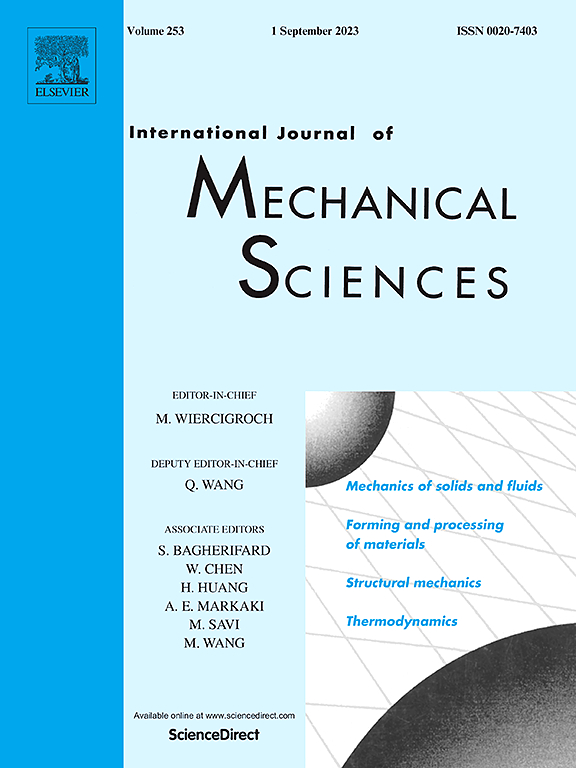相邻结构的优化调谐干涉负刚度阻尼器设计
IF 9.4
1区 工程技术
Q1 ENGINEERING, MECHANICAL
International Journal of Mechanical Sciences
Pub Date : 2025-06-07
DOI:10.1016/j.ijmecsci.2025.110454
引用次数: 0
摘要
本研究开发了利用调谐间质负刚度阻尼器(TINSD)对相邻结构进行最优振动控制的解析解,提供了基于h2范数优化的TINSD参数的封闭表达式,同时处理位移、速度和加速度响应。该系统的主要贡献在于明确的设计公式,通过结合干涉器和负刚度效应,将阻尼效果提高到传统粘性阻尼器的8倍;考虑质量/频率比和安装配置的实用参数确定框架;以及使用多个TINSD单元扩展到多模态控制,以减轻挑战性的高模态响应。参数研究检查了关键系统参数的影响,而使用20个地震记录的数值验证证明了跨结构配置的有效性。与现有的数值优化方法相比,导出的公式提供了具有理论严密性的实际工程指导,提供了具有明确物理解释的直接设计解决方案。多模态控制策略有效地解决了传统方法难以解决的高模态响应问题,将理论完备性与实际适用性相结合,推进了振动控制设计。这些发展通过分析优化和多模态缓解为相邻结构振动控制建立了系统方法,在保持工程实践实施可行性的同时,展示了显著的性能改进。本文章由计算机程序翻译,如有差异,请以英文原文为准。
Optimal tuned inerter negative stiffness damper design for adjacent structures
This study develops analytical solutions for optimal vibration control of adjacent structures using tuned inerter-negative-stiffness dampers (TINSD), providing closed-form expressions for TINSD parameters based on H2-norm optimization that simultaneously address displacement, velocity and acceleration responses. The key contributions are explicit design formulas improving damping effectiveness by up to 8 times compared to conventional viscous dampers through combined inerter and negative stiffness effects, a practical parameter determination framework considering mass/frequency ratios and installation configurations, and extension to multi-modal control using multiple TINSD units to mitigate challenging higher-mode responses. Parametric studies examine key system parameter influences, while numerical validations using 20 earthquake records demonstrate effectiveness across structural configurations. The derived formulas offer practical engineering guidelines with theoretical rigor, providing direct design solutions with clear physical interpretation compared to existing numerical optimization methods. The multi-modal control strategy effectively addresses higher-mode responses where conventional methods often struggle, advancing vibration control design by combining theoretical completeness with practical applicability. These developments establish a systematic approach for adjacent structure vibration control through analytical optimization and multi-modal mitigation, demonstrating significant performance improvements while maintaining implementation feasibility for engineering practice.
求助全文
通过发布文献求助,成功后即可免费获取论文全文。
去求助
来源期刊

International Journal of Mechanical Sciences
工程技术-工程:机械
CiteScore
12.80
自引率
17.80%
发文量
769
审稿时长
19 days
期刊介绍:
The International Journal of Mechanical Sciences (IJMS) serves as a global platform for the publication and dissemination of original research that contributes to a deeper scientific understanding of the fundamental disciplines within mechanical, civil, and material engineering.
The primary focus of IJMS is to showcase innovative and ground-breaking work that utilizes analytical and computational modeling techniques, such as Finite Element Method (FEM), Boundary Element Method (BEM), and mesh-free methods, among others. These modeling methods are applied to diverse fields including rigid-body mechanics (e.g., dynamics, vibration, stability), structural mechanics, metal forming, advanced materials (e.g., metals, composites, cellular, smart) behavior and applications, impact mechanics, strain localization, and other nonlinear effects (e.g., large deflections, plasticity, fracture).
Additionally, IJMS covers the realms of fluid mechanics (both external and internal flows), tribology, thermodynamics, and materials processing. These subjects collectively form the core of the journal's content.
In summary, IJMS provides a prestigious platform for researchers to present their original contributions, shedding light on analytical and computational modeling methods in various areas of mechanical engineering, as well as exploring the behavior and application of advanced materials, fluid mechanics, thermodynamics, and materials processing.
 求助内容:
求助内容: 应助结果提醒方式:
应助结果提醒方式:


